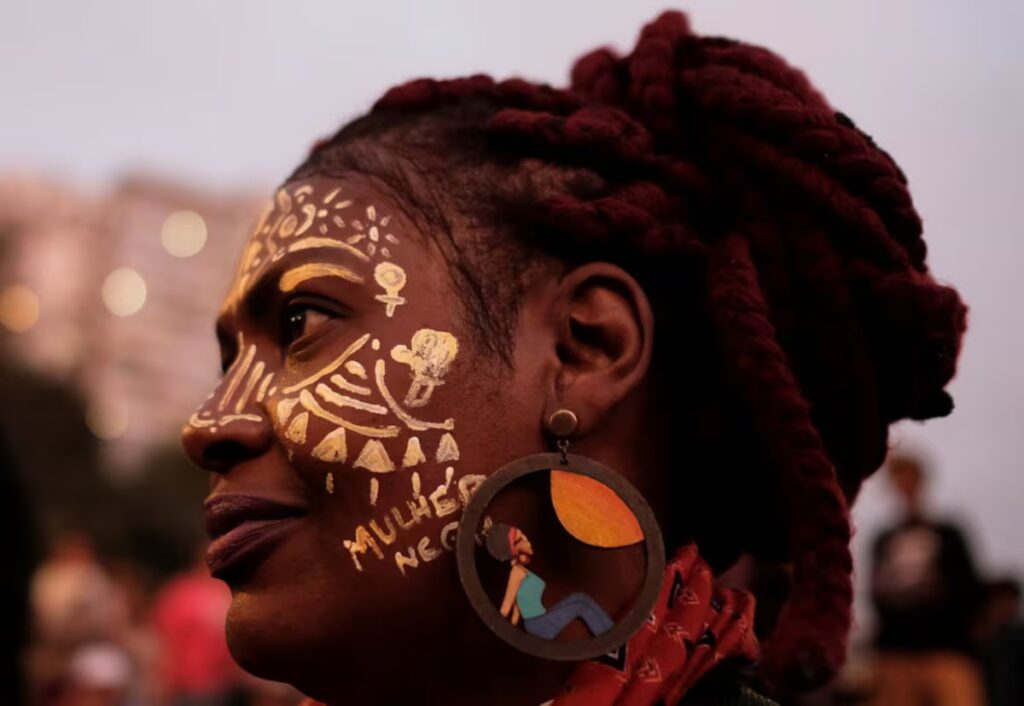
This November 25th Brasilia is the scene of a unique appeal: the Black Women’s March, whose motto is Repair and good living. “We need to build another world, imagine possible worlds and join forces to have a transnational strategy of denunciation and construction,” says Naiara Leite, 40 years old, from Salvador de Bahía, coordinator of the Odara Institute and the National March Committee. “There are almost 60 million black women in the country. If we can raise awareness among more than a million of them, we’ll be fine,” Leite says.
UNDP data confirms this magnitude: black women represent 28.5% of the Brazilian population and, despite this, they are the ones who experience the greatest inequalities, a reality that is repeated throughout Latin America. Organizers expect around 300,000 participants. The march has a global committee that has articulated months of regional and international work to convene Afro-descendant women from Latin America, the Caribbean and other continents. The notion of Americannesscoined by the Brazilian philosopher Lélia González, this November pours into the arteries of the Brazilian capital: a living process of resistance and creation that starts from African matrices and which has forged its identity in the Americas.
But the march is not an isolated event. Brasilia pulsates with more than 50 activities – dialogues, meetings, agenda-setting – that seek to strengthen struggles for equity, democracy, climate justice, the fight against religious racism, land rights and a life without violence for young black people. In its futuristic architecture, the city of concrete and glass receives a mobilization whose axis will be the National Museum, in the Plaza de los Tres Poderes.
This edition is the direct continuity of the 2015 march, which brought together nearly 100,000 black women and established a new cycle in the political organization and visibility of this movement. “Since then, we have seen a huge increase in candidates coming from black women, and Marielle Franco (the murdered black councilor of Rio de Janeiro) is also a result of this process,” explains Ingrid Farias, director of articulation at the Update Institute. And she adds that, since 2016, “many black women’s collective organizations have emerged and spearheaded discussions about race, black beauty, and positive aesthetics.” However, the gap in political inclusion of women, in general, and of Afro-descendants in particular, continues to be enormous. According to the Inter-Parliamentary Union IPU ranking, Brazil ranks 132nd in the world in terms of women’s representation, with less than 19% in parliament, behind countries such as Jordan and Turkey.
Despite this, from Colombia, the anthropologist, anti-racist activist and pre-candidate for the Senate for the Historical Pact, Amanda Hurtado, recognizes the influence of Brazilian women in the struggle. For her, the Brazilian experience is not just a source of inspiration: it marks a path. “I had very important conversations with my Brazilian colleagues – Ingrid, Fabiana – and we always exchanged things. This was the legacy of the Brazilian movement,” she says. This legacy, she adds, is twofold: demonstrating that it is possible to engage in radical politics starting from black women and fearlessly contesting spaces of power.
Hurtado underlines that the Brazilian movement has been able to exactly combine the strength of the social movement with that of the party system. “I read it as a movement that knows different mechanisms to access power,” he says. This articulation – her “movement-party” – is, for her, one of the most powerful lessons that Brazil brings to progressivism and the anti-racist left today: transforming structures requires occupying both the streets and the institutions.
In Mexico, home to more than 2.5 million Afro-Mexicans, half of them women, activist and community official Mijane Salinas looks to the Global March with hope and caution. For many Afro-Mexican women, dating is almost impossible: there are lack of resources, there are language gaps and information does not reach the communities. Nonetheless, the emergence of new groups and young leadership is recognised. For her, the meaning of the meeting is clear: collectivize the struggle, recognize and organize in the face of racism and violence. And it underlines another thing: this must be the moment in which we say together: “here we go, we need an opportunity”.
From Uruguay, Tania Ramírez – member of the Mizangas collective and regional coordinator of Update – agrees that Brazil is a political beacon for the region. “Brazilian colleagues have always been an example and a reference for many of us,” he says before going to Brasilia, recalling how every progress resonates in Uruguay, Argentina and Paraguay. But what moves her most is what she reports: “She will not just march, but will return and contest its meaning, demonstrating that there is a black and diasporic feminist movement, which imagines other possible futures.”
In Brasilia the march condenses all these urgencies. It is the result of extensive work in the 27 Brazilian states, with state, municipal and regional committees promoted by the women themselves, in addition to 16 committees made up of Latinas and women from other continents. “We march for reparation, which is the debt that the state owes to black women and the families of victims of state violence,” says Fabiana Pinto, of Mujeres Negras Deciden.
The slogan is not abstract: October’s mega police operation in Rio, with 121 deaths, left women, mostly black, walking among bodies to identify their relatives.
Good Living proposes the opposite: a full life free of violence. «It’s not just about surviving, but about living with dignity, with territory, health, memory and future», summarizes Pinto. This vision also guided the Action Plan for Good Living, presented at COP30, which calls for the political participation of Amazonian women to counter environmental racism.
The final document of the march will establish a collective agenda aimed at the historical reparation of racism and a model of society in which black women are recognized as political subjects and custodians of life and territories.
In the end, what happens in Brasilia does not stay in Brasilia. The march opens a horizon that goes beyond borders and is interpreted from a regional, ancestral and future perspective. The Afro-Uruguayan Ramírez summarizes it in a very symbolic image: the Sankofa, one of the Adinkra symbols of the Akan people of Ghana. It has two classic shapes: one is the heart, present in many buildings on our continent; and the other is that of the little bird with its beak backwards, guarding an egg, but flying forwards. The past, but moving towards the future,” he explains.
That memory of walking is linked to what Amanda Hurtado imagines from Colombia: that the march promotes a regional political platform, capable of thinking about a project for the Latin American majorities beyond the boundaries of identity. In his words: “The Latino shaming that Donald Trump put us through wasn’t just for black people, it was for the entire Latino community.”
At this intersection of memories, struggles and futures, the march reveals what is perhaps its deepest core. As Hurtado states: “The Black Women’s March in Brazil is a hope… for all global anti-systemic and anti-racist movements. From black women there is a collective proposal for humanity.”
Like the Sankofas invoked by Ramírez, black women from Latin America, the Caribbean and all parts of the world advance without liberating the egg of the future: guided by their ancestors, supported by memory and willing to imagine – and reclaim – the other possible worlds that this march has dared to name.





